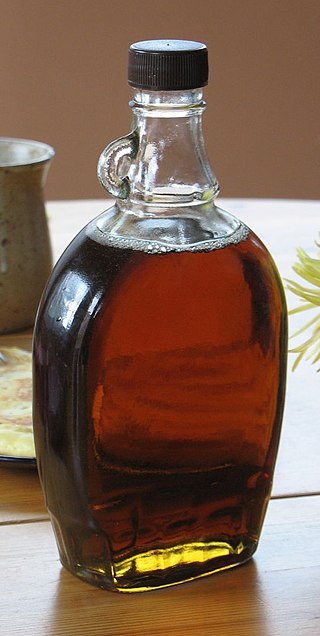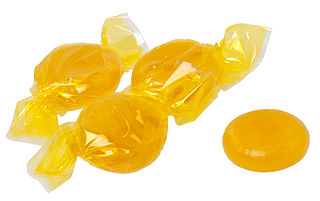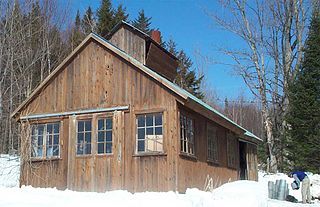
Dessert is a course that concludes a meal. The course consists of sweet foods, such as candy, and possibly a beverage such as dessert wine and liqueur. In some parts of the world, such as Greece and West Africa, and most parts of China, there is no tradition of a dessert course to conclude a meal.

Maple syrup is a syrup made from the sap of maple trees. In cold climates, these trees store starch in their trunks and roots before winter; the starch is then converted to sugar that rises in the sap in late winter and early spring. Maple trees are tapped by drilling holes into their trunks and collecting the sap, which is processed by heating to evaporate much of the water, leaving the concentrated syrup.

New England cuisine is an American cuisine which originated in the New England region of the United States, and traces its roots to traditional English cuisine and Native American cuisine of the Abenaki, Narragansett, Niantic, Wabanaki, Wampanoag, and other native peoples. It also includes influences from Irish, French, Italian, and Portuguese cuisine, among others. It is characterized by extensive use of potatoes, beans, dairy products and seafood, resulting from its historical reliance on its seaports and fishing industry. Corn, the major crop historically grown by Native American tribes in New England, continues to be grown in all New England states, primarily as sweet corn although flint corn is grown as well. It is traditionally used in hasty puddings, cornbreads and corn chowders.

Confectionery is the art of making confections, which are food items that are rich in sugar and carbohydrates. Exact definitions are difficult. In general, however, confectionery is divided into two broad and somewhat overlapping categories: bakers' confections and sugar confections. The occupation of confectioner encompasses the categories of cooking performed by both the French patissier and the confiseur.

Maple sugar is a traditional sweetener in Canada and the northeastern United States, prepared from the sap of the maple tree.

Butterscotch is a type of confectionery whose primary ingredients are brown sugar and butter. Some recipes include corn syrup, cream, vanilla, and salt. The earliest known recipes, in mid-19th century Yorkshire, used treacle (molasses) in place of, or in addition to, sugar.

Canadian cuisine consists of the cooking traditions and practices of Canada, with regional variances around the country. First Nations and Inuit have practiced their own culinary traditions in what is now Canada since time immemorial. The advent of European explorers and settlers, first on the east coast and then throughout the wider territories of New France, British North America and Canada, saw the melding of foreign recipes, cooking techniques, and ingredients with indigenous flora and fauna. Modern Canadian cuisine has maintained this dedication to local ingredients and terroir, as exemplified in the naming of specific ingredients based on their locale, such as Malpeque oysters or Alberta beef. Accordingly, Canadian cuisine privileges the quality of ingredients and regionality, and may be broadly defined as a national tradition of "creole" culinary practices, based on the complex multicultural and geographically diverse nature of both historical and contemporary Canadian society.
Penuche is a fudge-like candy made from brown sugar, butter, and milk, using no flavorings except for vanilla. Penuche often has a tannish color, and is lighter than regular fudge. It is formed by the caramelization of brown sugar; thus, its flavor is said to be reminiscent of caramel. Nuts, especially pecans, are often added to penuche for texture, frequently in the making of penuche candies. It is primarily a regional food, found in New England and some places in the Southern United States, though in the latter it goes by different names, including creamy praline fudge, and brown sugar fudge candy.

Maple taffy is a sugar candy made by boiling maple sap past the point where it would form maple syrup, but not so long that it becomes maple butter or maple sugar. It is part of traditional culture in Quebec, Eastern Ontario, New Brunswick and northern New England. In these regions, it is poured onto the snow, then lifted either with a small wooden stick, such as a popsicle stick, or a metal dinner fork.

Sugar bush refers to a forest stand of maple trees which is utilized for maple syrup. This was originally an Indigenous camp set up for several weeks each spring, beginning when the ice began to melt and ending when the tree buds begin to open. At a traditional sugarbush, all the trees were hand tapped and the sap was boiled over wood fires. The Anishinaabe (Ojibwe) peoples have been doing sugarbush for generations and consider the process both a part of food and of medicine.

A sugar shack, also known as sap house, sugar house, sugar shanty or sugar cabin is an establishment, primarily found in Eastern Canada and northern New England. Sugar shacks are small cabins or groups of cabins where sap collected from maple trees is boiled into maple syrup. They are often found on the same territory as the sugar bush, which is intended for cultivation and production of maple syrup by way of craftsmanship.
The following outline is provided as an overview of and topical guide to chocolate:
Maple liqueur refers to various alcoholic products made from maple syrup, primarily in the Northeast United States and Canada. It is most commonly made by mixing Canadian rye whiskey and Canadian maple syrup. Maple liqueur is considered an important cultural beverage in certain Canadian festivals.




















